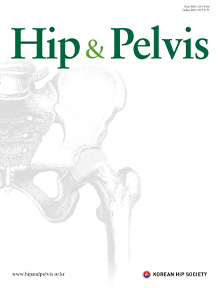Original Article
J Korean Hip Soc 2011; 23(4): 268-274
Published online December 1, 2011
© The Korean Hip Society
Ceramic-on-Ceramic Bearing Total Hip Arthroplasty: Five-Year Midterm Follow-up Results
Correspondence to : Sang Hyok Lee, MD
Department of Orthopedic Surgery, Soonchunhyang University Bucheon Hospital, 1174 Jung-dong, Wonmi-gu, Bucheon 420- 767, Korea
TEL: +82-32-621-5258 FAX: +82-32-621-5018
E-mail: sang158@hanmail.net
Purpose: We believe that cemented femoral stems will relieve the stiffness of ceramic-based bearings, resulting in reduced complication of ceramic-on-ceramic bearing total hip arthroplasty (THA). The purpose of this study was to evaluate the midterm effect of ceramic-on-ceramic bearing THA using cemented femoral stems.
Materials and Methods: We studied 32cases (30 patients) of THA using ceramic-on-ceramic bearing cemented femoral stems and 33 cases (31 patients) of THA using ceramic-on-ceramic bearing cementless femoral stems. All total hip arthroplasties were performed between January 2004 and December 2005 and were followed up for more than 5 years. The clinical results and radiographic results were evaluated.
Results: The mean HHS improved from points pre-operatively to points at the last follow-up in both the cemented and cementless stem groups (P<0.05). The mean WOMAC score also improved from points pre-operatively to points at the last follow-up in both the cemented and cementless stem groups (P<0.05). But no statistically significant difference was noted between the cemented and cementless stem groups in HHS and WOMAC scores (P=0.304, P=0.769). There were 3 patients with a sense of discomfort on ambulation and 5 patients with thigh pain in the cementless stem group and no cases in the cemented stem group. There was no instance of acetabular loosening in either group. Subsidenc of the cemented femoral stem was less than 1mm in 30 cases and less than 2 mm in 2 cases. All cementless femoral stems acquired firm bony union.
Conclusion: Midterm results showed no statistical links between ceramicon-ceramic-bearing THA using cemented femoral stems or cementless femoral stems.
Keywords Hip, Total hip arthroplasty, Ceramic-on-ceramic articulation, Cemented femoral stem
Article
Original Article
J Korean Hip Soc 2011; 23(4): 268-274
Published online December 1, 2011 https://doi.org/10.5371/jkhs.2011.23.4.268
Copyright © The Korean Hip Society.
Ceramic-on-Ceramic Bearing Total Hip Arthroplasty: Five-Year Midterm Follow-up Results
Soo Jae Yim, MD, Mun Suk Jang, MD, Joon Hee Yoon, MD, Sang Hyok Lee, MD, Hee kyung Kang, RN
Department of Orthopedic Surgery, Soonchunhyang University Bucheon Hospital, Bucheon, Korea
Correspondence to:Sang Hyok Lee, MD
Department of Orthopedic Surgery, Soonchunhyang University Bucheon Hospital, 1174 Jung-dong, Wonmi-gu, Bucheon 420- 767, Korea
TEL: +82-32-621-5258 FAX: +82-32-621-5018
E-mail: sang158@hanmail.net
Abstract
Purpose: We believe that cemented femoral stems will relieve the stiffness of ceramic-based bearings, resulting in reduced complication of ceramic-on-ceramic bearing total hip arthroplasty (THA). The purpose of this study was to evaluate the midterm effect of ceramic-on-ceramic bearing THA using cemented femoral stems.
Materials and Methods: We studied 32cases (30 patients) of THA using ceramic-on-ceramic bearing cemented femoral stems and 33 cases (31 patients) of THA using ceramic-on-ceramic bearing cementless femoral stems. All total hip arthroplasties were performed between January 2004 and December 2005 and were followed up for more than 5 years. The clinical results and radiographic results were evaluated.
Results: The mean HHS improved from points pre-operatively to points at the last follow-up in both the cemented and cementless stem groups (P<0.05). The mean WOMAC score also improved from points pre-operatively to points at the last follow-up in both the cemented and cementless stem groups (P<0.05). But no statistically significant difference was noted between the cemented and cementless stem groups in HHS and WOMAC scores (P=0.304, P=0.769). There were 3 patients with a sense of discomfort on ambulation and 5 patients with thigh pain in the cementless stem group and no cases in the cemented stem group. There was no instance of acetabular loosening in either group. Subsidenc of the cemented femoral stem was less than 1mm in 30 cases and less than 2 mm in 2 cases. All cementless femoral stems acquired firm bony union.
Conclusion: Midterm results showed no statistical links between ceramicon-ceramic-bearing THA using cemented femoral stems or cementless femoral stems.
Keywords: Hip, Total hip arthroplasty, Ceramic-on-ceramic articulation, Cemented femoral stem

Article Tools
Stats or Metrics
Related articles in H&P
-
Change of Symptoms after Total Hip Arthroplasty in Patients with Hip-Spine Syndrome
Sung-Hyun Yoon, MD, Ju Hyun Kim, MD, Hyung Jun Lee, MD, Ki-Choul Kim, MD, PhD
Hip Pelvis 2023; 35(4): 238-245 -
Cementless Total Hip Arthroplasty using Ceramic-on-ceramic Summit® System: 3 years follow up
Ick-Hwan Yang, M.D., Sang-Hoon Park, M.D., Chang-Dong Han, M.D.
J Korean Hip Soc 2007; 19(1): 9-15 -
Ceramic on Ceramic Hybrid Type Total Hip Arthroplasty in Patients with more than 65 years of Age -Minimum 5-year Follow-up Results
Song-Lee, M.D., Jin-Hak Kim, M.D., Dong-Oh Ko M.D., Young-Won Jeon, M.D., Seung-Jin Yang, M.D., Chang-Wook Ryu, M.D.
J Korean Hip Soc 2008; 20(2): 91-97




 PDF
PDF Standard view
Standard view Export citation
Export citation Share
Share  Previous Article
Previous Article



